Mosaic: small tiles go large
Texto por Alyn Griffiths
London, Reino Unido
09.09.15
Around for thousands of years, mosaic ceramic tiles are experiencing an architectural renaissance internationally thanks to a rethinking of their functional and aesthetic potential.
A mosaic made from white glass and Carrara marble covers the surfaces surrounding the entrances and windows of the Lakewood Garden Mausoleum by HGA; photo:Paul Crosby
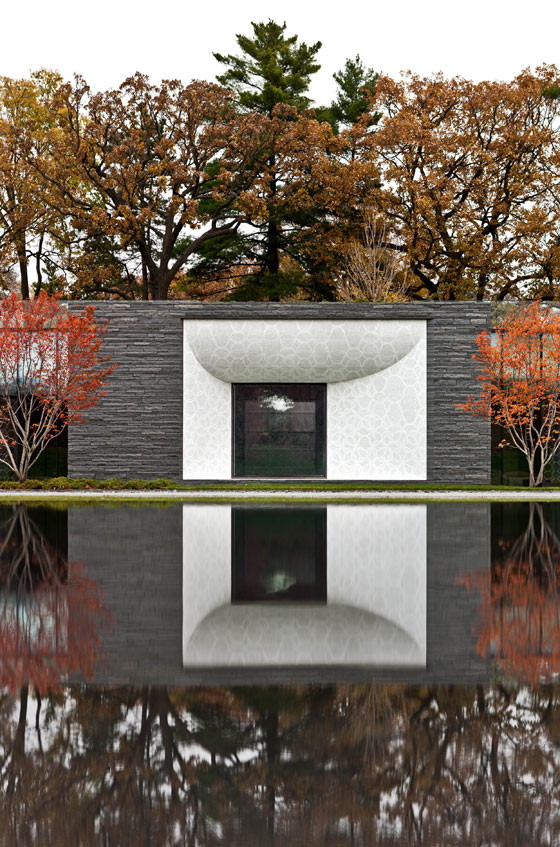
A mosaic made from white glass and Carrara marble covers the surfaces surrounding the entrances and windows of the Lakewood Garden Mausoleum by HGA; photo:Paul Crosby
×Mosaic has been used for millennia to lend aesthetic value to important monuments and edifices, typically with intricate scenes composed of hundreds or thousands of tiny tiles. From the temples of Ancient Greece and Rome, to the expressive multi-coloured walls of Antoni Gaudí’s Park Güell in Barcelona, the application of mosaic surfaces helps to elevate the status of these structures.
Contemporary architects are exploring both the functional and decorative potential of mosaic, applying it to entire facades or as a detail that evokes traditional craftsmanship. In an era when the architectural landscape is dominated by buildings erected quickly and cheaply using mass-manufactured materials, mosaic offers an alternative that clearly expresses the care and skill involved in its creation.
The contrast between the handmade decoration and the rough, split-faced granite was implemented to suggest a threshold between life and the afterlife, photo: Paul Crosby
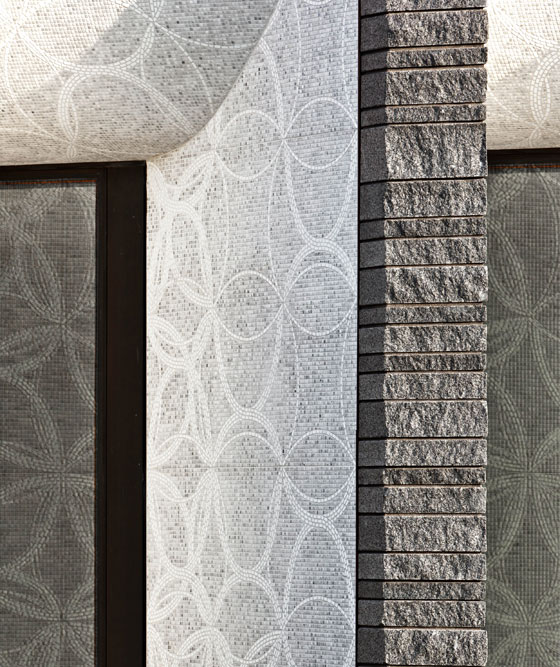
The contrast between the handmade decoration and the rough, split-faced granite was implemented to suggest a threshold between life and the afterlife, photo: Paul Crosby
×The emotive quality of this handcrafted decoration is particularly suited to religious architecture, where artisanal decoration has always been key to emphasising a building’s value. A recent example can be found at the Lakewood Garden Mausoleum in Minneapolis, where American architecture firm HGA specified a monochrome mosaic for the surfaces surrounding the entrance and windows. This application of an artisanal process introduces evidence of a human touch at the threshold between the building’s exterior and the spiritual sanctuary within.
The mosaic is formed using small pieces of Carrara marble and white glass applied in an abstract pattern that is intended to evoke both geometric and organic forms, as well as referencing the intricate decoration found in an adjacent chapel from 1910. Its subtle looping motifs and the gently curving surfaces contrast with the solidity of the split-faced grey granite cladding, creating what architect Joan Soranno describes as ‘an analogy between the earthbound and the spiritual – suggesting a metaphorical crossing over.’ The repetition of the pattern brings a sense of order to the facades, while its fine detailing adds a degree of artistry befitting a sacred space.
Surfaces throughout the renovated Delft railway station are decorated with a mosaic of white and blue tiles that evokes the city’s famous ceramics; photo: Koninklijke Mosa

Surfaces throughout the renovated Delft railway station are decorated with a mosaic of white and blue tiles that evokes the city’s famous ceramics; photo: Koninklijke Mosa
×The surfaces recall the decoration favoured by Spanish architect Antoni Gaudí and offer a more contemporary aesthetic than traditional mosaic; photo: Koninklijke Mosa
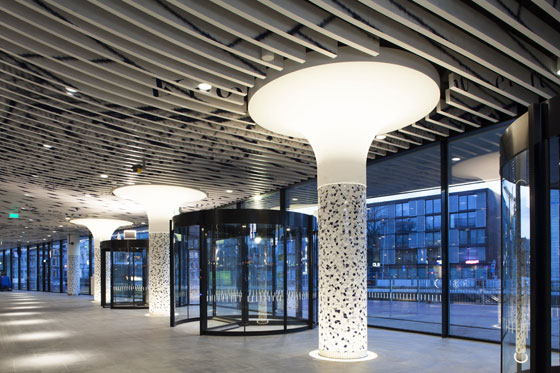
The surfaces recall the decoration favoured by Spanish architect Antoni Gaudí and offer a more contemporary aesthetic than traditional mosaic; photo: Koninklijke Mosa
×Traditional applications of mosaic have an enduring appeal, but architects today are also exploring ways of introducing mosaic into new contexts whilst retaining its artisanal associations. The Dutch city of Delft is synonymous with its blue and white ceramics, so local architecture firm Mecanoo decided to incorporate references to this familiar material in its renovation of the city’s main railway station. Several visual interpretations of the famous Delftware can be found throughout the project, including surfaces clad in a Gaudí-esque crackled mosaic.
The mosaic applied to walls and columns comprises small pieces of blue and white ceramic from tile manufacturer Mosa. Mosaic offered the most practical solution for the curving surfaces, which would otherwise have required costly three-dimensionally moulded tiles. Careful research into the properties of Delft ceramics determined the proportion of white to blue tiles in the design, with the blue elements produced in three different hues. ‘The result is lively yet harmonious,’ say Mosa. ‘It is a modern interpretation of Delft blue ceramic in a down-to-earth Dutch manner.
The tiles extend across the interior of a funnel that stretches to the surface and brings light into the subterranean spaces; photo: Andrea Resmini
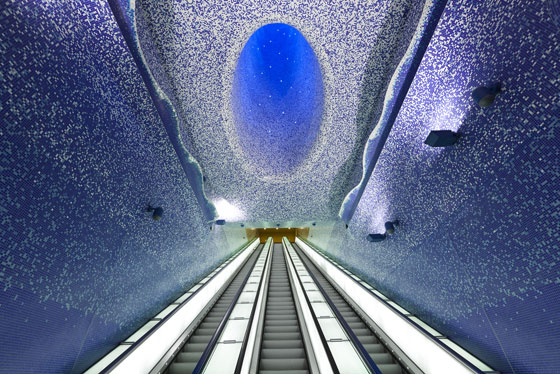
The tiles extend across the interior of a funnel that stretches to the surface and brings light into the subterranean spaces; photo: Andrea Resmini
×Architect Oscar Tusquets Blanca wanted to create the impression of being beneath the sea in parts of the station that are below sea level, photo: Andrea Resmini

Architect Oscar Tusquets Blanca wanted to create the impression of being beneath the sea in parts of the station that are below sea level, photo: Andrea Resmini
×Another example of a public infrastructure project spectacularly adorned with a modern mosaic is the Toledo metro station in the Italian city of Naples, which was designed by Spanish architect Oscar Tusquets Blanca. Tasked with decorating the station’s interior as part of a programme of artist-designed metro stops across the city, the architect covered the interior of an enormous crater that stretches from the surface to the platforms 38 metres below in a mosaic of blue tiles. The crater enables natural light entering through skylights set in the piazza above ground to filter down into the circulation spaces.
Along with the interior of the light funnel, the mosaic is applied only to surfaces in areas of the station that are below sea level. It is formed from tiles produced by Italian firm Bisazza and is intended to evoke the feeling of being beneath the sea. The glazed surfaces of the tiles help to reflect the sunlight entering during the day, and light emitted by LEDs scattered along the length of the funnel-shaped void later in the day. The use of mosaic gives the spaces a random, organic aesthetic that complements the underwater theme.
The facades of the North Bondi Surf Life Saving Club by Durbach Block Jaggers are entirely clad in an irregular pattern of mosaic tiles that wrap around its curving corners; photo: John Gollings
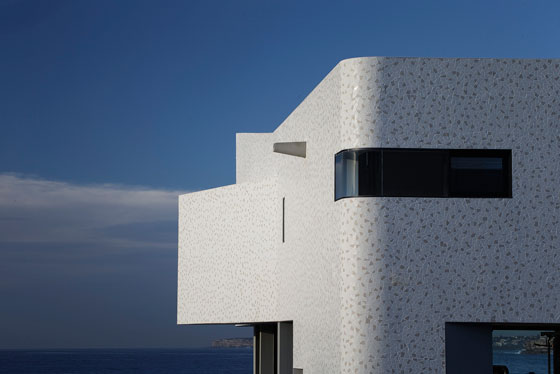
The facades of the North Bondi Surf Life Saving Club by Durbach Block Jaggers are entirely clad in an irregular pattern of mosaic tiles that wrap around its curving corners; photo: John Gollings
×The vitrified surfaces of glazed ceramic tiles mean that mosaic also provides a practical solution in projects where a hard-wearing material is required. Sydney architecture studio Durbach Block Jaggers chose to clad the entire exterior of its sculptural building for the North Bondi Surf Life Saving Club in a mosaic of irregular white, cream and grey tiles that forms a resilient shell around the building, protecting it from the corrosive salt water spray that damages many seafront structures. The tessellated surfaces extend around the building’s curving corners and the edges of a dramatic scoop that interrupts the sea-facing elevation to provide a rooftop vantage point. The architects were able to vary the proportion of gloss and matt tiles around the building, with the more exposed southern and eastern facades incorporating a greater number of gloss tiles to protect them from the harsh conditions.
The size and asymmetric forms of the tiles gives the exterior cladding a dynamic textured aesthetic that is accentuated when car headlights sweep across it at night, producing a sparkling effect that architect Neil Durbach says was ‘an unexpected bonus’. The interior surfaces of the rooftop terrace are clad in a mosaic of smaller square tiles in six different blue hues, selected to evoke the changing qualities of the sky and the sea. The varying hues of the glossy tiles and the reflections produced by the changing light during the day results in a heterogeneous surface that emphasises the swooping wave-like form of the courtyard, which Durbach describes as ‘fluid and gentle, sensuous and slippery’.
A more conventional mosaic made from different shades of blue tiles that reference the changing sea and sky clads the building’s rooftop terrace; photo: John Gollings

A more conventional mosaic made from different shades of blue tiles that reference the changing sea and sky clads the building’s rooftop terrace; photo: John Gollings
×The diverse uses architects are finding for mosaic – both as external cladding or as an abstract decorative surface in large-scale infrastructure projects – demonstrates the material’s fundamental versatility. Visitors to the upcoming Cersaie tile and bathroom furnishings event, which will be held in the Italian city of Bologna from 28 September until 2 October, can expect mosaic to feature prominently, and the exhibition may help to inspire the next generation of innovative mosaic projects.







